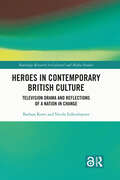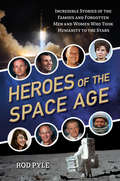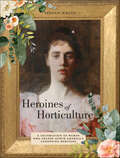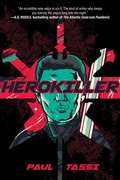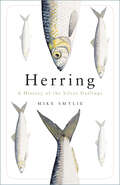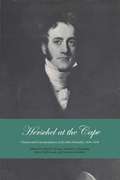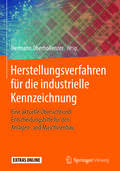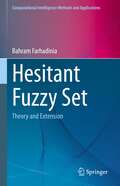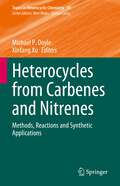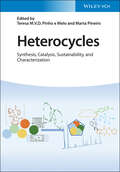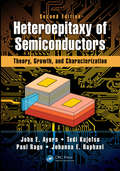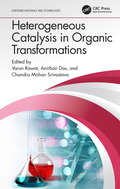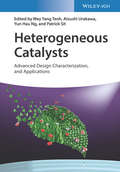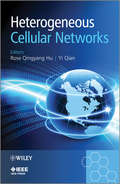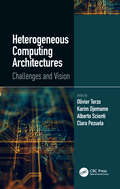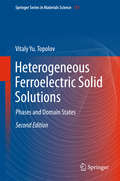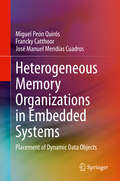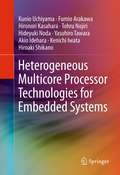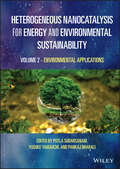- Table View
- List View
Heroes & Villains: Inside the minds of the greatest warriors in history
by Frank McLynnIn the history of warfare, an elite group of men have attained almost legendary status through their courage, ambition and unrivalled military genius. But many of these same men possessed deep personal character flaws. In Heroes & Villains, acclaimed historian Frank McLynn focuses on six of the most powerful and magnetic leaders of all time: Spartacus, Attila the Hun, Richard the Lionheart, Cortés, Tokugawa Ieyasu and Napoleon. How did these mortal men rise to positions of seemingly invincible power? What were the motives, the personal strengths and often weaknesses that drove them to achieve what no one else dared? In six powerful portraits, McLynn brilliantly evokes the critical moments when each of these warriors proved themselves in battle, changing their own lives, the destiny of their people and, in some cases, the history of the world. We discover what drove Spartacus to take on the might of Rome against seemingly impossible odds, and how the young Napoleon rose to power in dramatic fashion at the Siege of Toulon. Heroes & Villains is more than a collection of individual biographies. By examining the complex psychologies of these extraordinary men, McLynn builds up a convincing profile of the ultimate warrior. Accompanying a major BBC television series, this brilliant book takes us into the minds of the greatest warriors in history.
Heroes in Contemporary British Culture: Television Drama and Reflections of a Nation in Change (Routledge Research in Cultural and Media Studies)
by Nicole Falkenhayner Barbara KorteThis book explores how British culture is negotiating heroes and heroisms in the twenty-first century. It posits a nexus between the heroic and the state of the nation and explores this idea through British television drama.Drawing on case studies including programmes such as The Last Kingdom, Spooks, Luther and Merlin, the book explores the aesthetic strategies of heroisation in television drama and contextualises the programmes within British public discourses at the time of their production, original broadcasting and first reception. British television drama is a cultural forum in which contemporary Britain’s problems, wishes and cultural values are revealed and debated. By revealing the tensions in contemporary notions of heroes and heroisms, television drama employs the heroic as a lens through which to scrutinise contemporary British society and its responses to crisis and change. Looking back on the development of heroic representations in British television drama over the last twenty years, this book’s analyses show how heroisation in television drama reacts to, and reveals shifts in, British structures of feeling in a time marked by insecurity.The book is ideal for readers interested in British cultural studies, studies of the heroic and popular culture.Introduction of this book is freely available as a downloadable Open Access PDF at http://www.taylorfrancis.com under a Creative Commons [Attribution (CC-BY-)] 4.0 license.
Heroes of the Space Age: Incredible Stories of the Famous and Forgotten Men and Women Who Took Humanity to the Stars
by Rod PyleA NASA insider tells the exciting story of the people, some well-known but many unrecognized, who were responsible for so many daring space missions.Award-winning science writer Rod Pyle profiles the remarkable pilots, scientists, and engineers whose work was instrumental in space missions to every corner of our solar system and beyond. Besides heralded names like Neil Armstrong, John Glenn, and Gene Kranz, the author highlights some of the "hidden figures" who played crucial roles in the success of NASA, Soviet, and international space exploration. For example, Valentina Tereshkova was the first woman to travel into space, aboard Soviet spacecraft Vostok 6. American Margaret Hamilton was an accomplished mathematician and one of the first female software engineers to design programs for spaceflight, software that proved critical to the success of the moon landing. And Pete Conrad, "salty sailor of the skies," flew twice in the Gemini programs, landed on the moon in Apollo 12, and was the commander of the first crew to visit America's new Skylab space station--its first ever--in 1973.Complemented by many rarely-seen photos and illustrations, these stories of the highly talented and dedicated people, many of whom worked tirelessly behind the scenes, will fascinate and inspire.
Heroines of Horticulture: A Celebration of Women Who Shaped North America's Gardening Heritage
by Stefan WhiteA celebration and a salute to 100 brave, determined, creative women over the past few centuries who have shaped North America’s heritage and landscapes through their horticulture work and contributions. Through tales of invention, creativity, dogged research, innovation, perspiration, and inspiration spanning from the early 1700s to the mid-1980s, Heroines of Horticulture offers readers insight into 100 influential women who met and overcame obstacles to contribute a horticulture legacy that has helped shape the land that surrounds us today in North America. Many of the featured women are unknown or forgotten figures of horticulture history, making this book an overdue opportunity to acknowledge their work and celebrate their achievements that have left a lasting legacy. Profiles include the following: Martha Danielle Logan (1704–1779): An early American botanist who was instrumental in seed exchanges between Britain and the North American colonies. She wrote an influential gardening advice column and was a major collector of plants endemic to the Carolinas. Annie Linda Jack (1839–1912): The first Canadian professional female garden writer. Upon her marriage, she had stipulated for 1 acre of land to be devoted to any department of horticulture she chose, the profits to be her own pocket money. She wrote about her experiences in the Rural New Yorker, under the title "A Woman's Acre." The American horticulturalist Liberty Hyde Bailey referred to Annie Linda Jack's garden as "one of the most original gardens I know." Mary Gibson Henry (1884–1967): An American botanist and plant collector from Lower Merion Township, Pennsylvania, near Philadelphia, who also served as president of the American Horticultural Society. The daylily Hymenocallis henryae is named in her honor. Nelva Weber (1908–1990): An American landscape architect who wrote extensively about landscape design. She opened her practice in 1945 in New York City. Prior to that, she worked on the Palisades Parkway with C. C. Combs. She was also employed by the architecture firm Shaw Maess & Murphy and later as a designer on city parks for the New York City Parks Department. And many more Heroines of Horticulture is the perfect addition to the shelves and coffee tables of gardening enthusiasts and women’s history and feminist history readers and makes a great gift for anyone with a love of gardening or landscape design and history.
Herokiller: A Novel
by Paul Tassi“An incredible new voice in sci-fi. The kind of writer who keeps you turning the pages long into the night.”—A.G. Riddle, bestselling author of The Atlantis Gene and PandemicReady Player One meets Gladiator in this high-octane thriller that mixes black-ops espionage with fight-to-the-death combat in the arena. In the near future, the line between entertainment and brutality has blurred. Mysterious billionaire Cameron Crayton is a household name from televised spectacles in which prison inmates fight to the death, but his old shows pale in comparison to his new event, The Crucible, a gladiatorial tournament anyone can enter. The winner is promised unimaginable wealth and glory . . . if they’re able to survive a series of globally broadcast fight-to-the-death matches with medieval weaponry against the world’s most fearsome fighters. Former black-ops operative Mark Wei wants nothing more than to be left alone to drink after sacrificing everything?including his family?in America’s covert Cold War II against China, a war won largely because of him. But there are rumors that Crayton’s background and business dealings involve shady connections to foreign powers, and soon Mark is convinced to reluctantly dust off his training, strap on a sword and armor, and enter the tournament arena as an undercover agent. It’s the most dangerous assignment he’s ever been given, and Mark quickly finds himself not just fighting for his life in the arena against trained killers, but racing to expose The Crucible’s founder’s secrets while navigating a viral phenomenon in which the stakes are literally life and death. . . .
Herring: A History of the Silver Darlings
by Mike SmylieThe story of herring is entwined in the history of commercial fishing. For over two millennia, herring have been commercially caught and its importance to the coastal peoples of Britain cannot be measured. At one point tens of thousands were involved in the catching, processing and sale of herring. They followed the shoals around the coast from Stornoway to Penzance and many towns on Britain’s East Coast grew rich on the backs of the ‘silver darlings’. The book looks at the effects of the herring on the people who caught them, the unique ways of life, the superstitions of the fisher folk, their boats and the communities who lived for the silver darlings. With a wealth of illustrations, this fascinating book reveals the little-known history of the herring. And for those who’ve neglected the silver darlings for lesser fish such as cod and haddock, there are a number of mouth-watering recipes to try.
Herschel at the Cape: Diaries and Correspondence of Sir John Herschel, 1834-1838
by David S. Evans Terence J. Deeming Betty Hall Evans Stephen GoldfarbSir John Herschel, one of the founders of Southern Hemisphere astronomy, was a man of extraordinarily wide interests. He made contributions to botany, geology, and ornithology, as well as to astronomy, chemistry, and mathematics. Throughout his scientific career he kept a diary, recording his public and private life. The diaries from 1834 to 1838, years spent making astronomical observations at the Cape of Good Hope, are reproduced in this book and prove to be much more than an ordinary scientist''s logbook. They present personal and social history, literary commentaries, the results of close observations of nature and numerous scientific experiments, the excitement of travel, political intrigues, gossip, and philosophical reflections--all interpreted through an alert and versatile mind. In the present transcription, the material has been enriched with selected correspondence of Sir John and his wife Lady Herschel (neé Margaret Brodie Stewart). Sir John devoted his working time at the Cape primarily to a systematic observation of the southern sky, complementing his earlier "sweeping" of the northern sky at Slough, England. He later became one of the founders of photography, but at the Cape he used a simple optical device, the camera lucida, in the production of numerous landscape drawings. Many of these, along with reproductions of sketches contained in the diaries and botanical drawings made by Sir John and Lady Herschel, are used to illustrate this book. Sir John was also a leading spirit in the foundation of the educational system of the Cape and a supporter of exploratory expeditions into the interior. As the son of Sir William Herschel, in his day the most famous British astronomer and the discoverer of the planet Uranus, Sir John was already celebrated when he arrived from England. Every individual of note, resident at the Cape or visiting, went to see him. He was supported in his work by his wife, who ran an enormous establishment and bore a huge family, but who nevertheless found time to travel in the country round the western Cape with him and to assist in his observations. The diaries and letters are supplemented by especially valuable editorial notes that provide much needed and highly interesting information concerning persons and events mentioned and described by Sir John. All the original manuscript material used in this volume is held by the Harry Ransom Center at the University of Texas at Austin. Sir John''s camera lucida drawings are from the South African Public Library in Cape Town. Sir John Herschel, one of the founders of Southern Hemisphere astronomy, was a man of extraordinarily wide interests. He made contributions to botany, geology, and ornithology, as well as to astronomy, chemistry, and mathematics. Throughout his scientific career he kept a diary, recording his public and private life. The diaries from 1834 to 1838, years he spent making astronomical observations at the Cape of Good Hope, are reproduced in this book and prove to be much more than an ordinary scientist''s logbook. They present personal and social history, literary commentaries, the results of close observations of nature and numerous scientific experiments, the excitement of travel, political intrigues, gossip, and philosophical reflections - all interpreted through an alert and versatile mind. In the present transcription, the material has been enriched with selected correspondence of Sir John and his wife Lady Herschel (née Margaret Brodie Stewart). Sir John devoted his working time at the Cape primarily to a systematic observation of the southern sky, complementing his earlier "sweeping" of the northern sky at Slough, England. He later became one of the founders of photography, but at the Cape he used a simple optical device, the camera lucida, in the production of numerous landscape drawings. Many of these, along with reproductions of sketches contained in the diaries and botanical drawings made by Sir John and Lady Herschel, are used to illustrate this book. Sir John was also a leading figure i...
Herstellungsverfahren für die industrielle Kennzeichnung: Eine aktuelle Übersicht und Entscheidungshilfe für den Anlagen- und Maschinenbau
by Hermann OberhollenzerDieses Buch verschafft erstmals eine Übersicht über relevante Herstellungsverfahren für Kennzeichen, die im Anlagen- und Maschinenbau eingesetzt werden. Als Wegweiser soll es interessierte Anwender zum optimierten Kennzeichnen führen. Das Werk thematisiert wichtige Aspekte des Kennzeichnens, wozu Wirtschaftlichkeit und Leistungskapazität von Verfahren ebenso gehören wie deren Handhabung und eine Risikobewertung hinsichtlich Gesundheit und Umwelt. Das Buch und die korrespondierende App ermöglichen den Lesern/Anwendern, für einen definierten Bedarf optimale Kennzeichnungsverfahren zu identifizieren.Die ZielgruppenPraktiker in den Produktionsbetrieben (vor allem Maschinen- und Anlagenbau), die sich mit dem Thema „Kennzeichnen“ befassen. Für die Ausbildung im Maschinen- und Anlagenbau ist das Buch ein Lehrstück hinsichtlich „Wirtschaftlichkeit durch Beachtung von Randgebieten“.
Hesitant Fuzzy Set: Theory and Extension (Computational Intelligence Methods and Applications)
by Bahram FarhadiniaCovering a wide range of notions concerning hesitant fuzzy set and its extensions, this book provides a comprehensive reference to the topic. In the case where different sources of vagueness appear simultaneously, the concept of fuzzy set is not able to properly model the uncertainty, imprecise and vague information. In order to overcome such a limitation, different types of fuzzy extension have been introduced so far. Among them, hesitant fuzzy set was first introduced in 2010, and the existing extensions of hesitant fuzzy set have been encountering an increasing interest and attracting more and more attentions up to now. It is not an exaggeration to say that the recent decade has seen the blossoming of a larger set of techniques and theoretical outcomes for hesitant fuzzy set together with its extensions as well as applications.As the research has moved beyond its infancy, and now it is entering a maturing phase with increased numbers and types of extensions, this book aims to give a comprehensive review of such researches. Presenting the review of many and important types of hesitant fuzzy extensions, and including references to a large number of related publications, this book will serve as a useful reference book for researchers in this field.
Heterocycles from Carbenes and Nitrenes: Methods, Reactions and Synthetic Applications (Topics in Heterocyclic Chemistry #59)
by Michael P. Doyle Xinfang XuThis book provides researchers in the fields of organic chemistry, organometallic chemistry and homogeneous catalysis with an overview of recent developments in the applications of reactions involving carbene and nitrene intermediates directed to the synthesis of heterocyclic compounds. Multiple pathways through which diverse heterocyclic compounds are accessed occur from a variety of carbene and nitrene precursors through C-H/X-H insertions, cycloadditions, ylide transformations, rearrangements, and cascade reactions. Catalytic processes that form metallo-carbenes and nitrenes offer unparalleled chemo-, regio-, and stereo-selectivities. Insights are provided into the scope of these methodologies and the inherent control of catalyst ligands on reaction selectivities.
Heterocycles: Synthesis, Catalysis, Sustainability, and Characterization
by Teresa M.V.D. Pinho e Melo Marta PineiroA must-read handbook on heterocycle chemistry with a focus on sustainability Heterocycles feature prominently in our daily life—they are essential for pharmaceuticals, agrochemicals, and fine chemicals. More, numerous natural, bioactive products contain heterocyclic compounds. As a result, heterocyclic chemistry continues to be one of the most important areas of study in organic chemistry. Heterocycles provides an important reference on a wide range of topics relating to heterocyclic chemistry, with a heavy emphasis on sustainable methods and greener syntheses. The book describes state-of-the-art synthetic methods, such as photochemical reactions, dearomatization reactions, organocatalysis, transition metal catalysis, and biocatalysis. It also covers: Sustainable methods, like flow chemistry, mechanochemistry, and multicomponent synthesis Strategies for the synthesis of heterocyclic macrocycles and medium-sized rings Characterization of heterocyclic compounds Heterocycles is a useful reference for organic chemists, natural products chemists, catalytic chemists, and medicinal chemists in academia and industry.
Heteroepitaxy of Semiconductors: Theory, Growth, and Characterization, Second Edition
by John E. Ayers Tedi Kujofsa Paul Rago Johanna RaphaelIn the past ten years, heteroepitaxy has continued to increase in importance with the explosive growth of the electronics industry and the development of a myriad of heteroepitaxial devices for solid state lighting, green energy, displays, communications, and digital computing. Our ever-growing understanding of the basic physics and chemistry underlying heteroepitaxy, especially lattice relaxation and dislocation dynamic, has enabled an ever-increasing emphasis on metamorphic devices. To reflect this focus, two all-new chapters have been included in this new edition. One chapter addresses metamorphic buffer layers, and the other covers metamorphic devices. The remaining seven chapters have been revised extensively with new material on crystal symmetry and relationships, III-nitride materials, lattice relaxation physics and models, in-situ characterization, and reciprocal space maps.
Heterogeneous Catalysis at Nanoscale for Energy Applications
by Prashant V. Kamat Franklin Feng Tao William F. SchneiderThis book presents both the fundamentals concepts and latest achievements of a field that is growing in importance since it represents a possible solution for global energy problems. It focuses on an atomic-level understanding of heterogeneous catalysis involved in important energy conversion processes. It presents a concise picture for the entire area of heterogeneous catalysis with vision at the atomic- and nano- scales, from synthesis, ex-situ and in-situ characterization, catalytic activity and selectivity, to mechanistic understanding based on experimental exploration and theoretical simulation.The book:Addresses heterogeneous catalysis, one of the crucial technologies employed within the chemical and energy industriesPresents the recent advances in the synthesis and characterization of nanocatalysts as well as a mechanistic understanding of catalysis at atomic level for important processes of energy conversionProvides a foundation for the potential design of revolutionarily new technical catalysts and thus the further development of efficient technologies for the global energy economyIncludes both theoretical studies and experimental explorationIs useful as both a textbook for graduate and undergraduate students and a reference book for scientists and engineers in chemistry, materials science, and chemical engineering
Heterogeneous Catalysis in Organic Transformations (Emerging Materials and Technologies)
by Anirban Das Varun Rawat Chandra Mohan SrivastavaAs the broad challenges around energy and the environment have become the focus of much research, scientists and experts have dedicated their efforts to developing more active and selective catalytic systems for key chemical transformations. For many decades environmentally viable protocols for the synthesis of fine chemicals have been the crux of academic and industrial research. Heterogeneous Catalysis in Organic Transformations serves as an overview of this work, providing a complete description of role of heterogeneous catalysis in organic transformations and offering a review of the current and near future technologies and applications. Discusses the fundamentals of catalysis and compares the advantages and disadvantages of different types of catalyst systems Examines oxide nanoparticles and noble metal nanoparticles Consider organometallic compounds, solid-supported catalysts, and mesoporous materials Describes recent advances in metal-based heterogeneous catalysts and new reactions with possible mechanistic pathways Providing a comprehensive review of heterogeneous catalysis from the basics through recent advances, this book will be of keen interest to undergraduates, graduates, and researchers in chemistry, chemical engineering, and associated fields.
Heterogeneous Catalysts: Advanced Design, Characterization, and Applications
by Wey Yang TeohPresents state-of-the-art knowledge of heterogeneous catalysts including new applications in energy and environmental fields This book focuses on emerging techniques in heterogeneous catalysis, from new methodology for catalysts design and synthesis, surface studies and operando spectroscopies, ab initio techniques, to critical catalytic systems as relevant to energy and the environment. It provides the vision of addressing the foreseeable knowledge gap unfilled by classical knowledge in the field. Heterogeneous Catalysts: Advanced Design, Characterization and Applications begins with an overview on the evolution in catalysts synthesis and introduces readers to facets engineering on catalysts; electrochemical synthesis of nanostructured catalytic thin films; and bandgap engineering of semiconductor photocatalysts. Next, it examines how we are gaining a more precise understanding of catalytic events and materials under working conditions. It covers bridging pressure gap in surface catalytic studies; tomography in catalysts design; and resolving catalyst performance at nanoscale via fluorescence microscopy. Quantum approaches to predicting molecular reactions on catalytic surfaces follows that, along with chapters on Density Functional Theory in heterogeneous catalysis; first principles simulation of electrified interfaces in electrochemistry; and high-throughput computational design of novel catalytic materials. The book also discusses embracing the energy and environmental challenges of the 21st century through heterogeneous catalysis and much more. Presents recent developments in heterogeneous catalysis with emphasis on new fundamentals and emerging techniques Offers a comprehensive look at the important aspects of heterogeneous catalysis Provides an applications-oriented, bottoms-up approach to a high-interest subject that plays a vital role in industry and is widely applied in areas related to energy and environment Heterogeneous Catalysts: Advanced Design, Characterization and Applications is an important book for catalytic chemists, materials scientists, surface chemists, physical chemists, inorganic chemists, chemical engineers, and other professionals working in the chemical industry.
Heterogeneous Cellular Networks
by Xiaoli Chu David López-Pérez Yang Yang Fredrik GunnarssonThis detailed, up-to-date introduction to heterogeneous cellular networking introduces its characteristic features, the technology underpinning it and the issues surrounding its use. Comprehensive and in-depth coverage of core topics catalogue the most advanced, innovative technologies used in designing and deploying heterogeneous cellular networks, including system-level simulation and evaluation, self-organisation, range expansion, cooperative relaying, network MIMO, network coding and cognitive radio. Practical design considerations and engineering tradeoffs are also discussed in detail, including handover management, energy efficiency and interference management techniques. A range of real-world case studies, provided by industrial partners, illustrate the latest trends in heterogeneous cellular networks development. Written by leading figures from industry and academia, this is an invaluable resource for all researchers and practitioners working in the field of mobile communications.
Heterogeneous Cellular Networks
by Yi Qian Rose Qingyang HuA timely publication providing coverage of radio resource management, mobility management and standardization in heterogeneous cellular networksThe topic of heterogeneous cellular networks has gained momentum in industry and the research community, attracting the attention of standardization bodies such as 3GPP LTE and IEEE 802.16j, whose objectives are looking into increasing the capacity and coverage of the cellular networks. This book focuses on recent progresses, covering the related topics including scenarios of heterogeneous network deployment, interference management in the heterogeneous network deployment, carrier aggregation in a heterogeneous network, cognitive radio, cell selection/reselection and load balancing, mobility and handover management, capacity and coverage optimization for heterogeneous networks, traffic management and congestion control.This book enables readers to better understand the technical details and performance gains that are made possible by this state-of-the-art technology. It contains the information necessary for researchers and engineers wishing to build and deploy highly efficient wireless networks themselves. To enhance this practical understanding, the book is structured to systematically lead the reader through a series of case-studies of real world scenarios.Key features:Presents this new paradigm in cellular network domain: a heterogeneous network containing network nodes with different characteristics such as transmission power and RF coverage areaProvides a clear approach by containing tables, illustrations, industry case studies, tutorials and examples to cover the related topicsIncludes new research results and state-of-the-art technological developments and implementation issues
Heterogeneous Computing Architectures: Challenges and Vision
by Olivier Terzo, Karim Djemame, Alberto Scionti and Clara PezuelaHeterogeneous Computing Architectures: Challenges and Vision provides an updated vision of the state-of-the-art of heterogeneous computing systems, covering all the aspects related to their design: from the architecture and programming models to hardware/software integration and orchestration to real-time and security requirements. The transitions from multicore processors, GPU computing, and Cloud computing are not separate trends, but aspects of a single trend-mainstream; computers from desktop to smartphones are being permanently transformed into heterogeneous supercomputer clusters. The reader will get an organic perspective of modern heterogeneous systems and their future evolution.
Heterogeneous Ferroelectric Solid Solutions: Phases And Domain States (Springer Series in Materials Science #151)
by Vitaly Yu. TopolovThis book systematizes data on the heterophase states and their evolution in perovskite-type ferroelectric solid solutions. It also provides a general interpretation of heterophase and domain structures on changing temperature, composition or electric field, as well as the complete analysis of interconnections domain structures, unit-cell parameters changes, heterophase structures and stress relief. The description of numerous examples of heterophase states in lead-free ferroelectric solid solutions is also included. Domain state–interface diagrams contribute to the interpretation of heterophase states in perovskite-type ferroelectric solid solutions and describe the stress relief in the presence of polydomain phases, the behavior of unit-cell parameters of coexisting phases, the effect of external electric field etc. This 2nd edition generalizes the results on the heterophase ferroelectric solid solutions and the stress relief and presents new results on heterophase/domain structures and phase contents in lead-free ferroelectric solid solutions.
Heterogeneous Memory Organizations in Embedded Systems: Placement of Dynamic Data Objects
by Francky Catthoor Miguel Peón Quirós José Manuel Mendías CuadrosThis book defines and explores the problem of placing the instances of dynamic data types on the components of the heterogeneous memory organization of an embedded system, with the final goal of reducing energy consumption and improving performance. It is one of the first to cover the problem of placement for dynamic data objects on embedded systems with heterogeneous memory architectures, presenting a complete methodology that can be easily adapted to real cases and work flows. The authors discuss how to improve system performance and energy consumption simultaneously.Discusses the problem of placement for dynamic data objects on embedded systems with heterogeneous memory architectures;Presents a complete methodology that can be adapted easily to real cases and work flows;Offers hints on how to improve system performance and energy consumption simultaneously.
Heterogeneous Multicore Processor Technologies for Embedded Systems
by Tohru Nojiri Kenichi Iwata Fumio Arakawa Yasuhiro Tawara Kunio Uchiyama Hironori Kasahara Hiroaki Shikano Hideyuki Noda Akio IdeharaTo satisfy the higher requirements of digitally converged embedded systems, this book describes heterogeneous multicore technology that uses various kinds of low-power embedded processor cores on a single chip. With this technology, heterogeneous parallelism can be implemented on an SoC, and greater flexibility and superior performance per watt can then be achieved. This book defines the heterogeneous multicore architecture and explains in detail several embedded processor cores including CPU cores and special-purpose processor cores that achieve highly arithmetic-level parallelism. The authors developed three multicore chips (called RP-1, RP-2, and RP-X) according to the defined architecture with the introduced processor cores. The chip implementations, software environments, and applications running on the chips are also explained in the book. Provides readers an overview and practical discussion of heterogeneous multicore technologies from both a hardware and software point of view;Discusses a new, high-performance and energy efficient approach to designing SoCs for digitally converged, embedded systems;Covers hardware issues such as architecture and chip implementation, as well as software issues such as compilers, operating systems, and application programs;Describes three chips developed according to the defined heterogeneous multicore architecture, including chip implementations, software environments, and working applications.
Heterogeneous Nanocatalysis for Energy and Environmental Sustainability, Volume 1: Energy Applications
by Putla Sudarsanam Yusuke Yamauchi Pankaj BharaliAn essential companion for catalysis researchers and professionals studying economically viable and eco-friendly catalytic strategies for energy conversion In the two-volume Heterogeneous Nanocatalysis for Energy and Environmental Sustainability, a team of distinguished researchers deliver a comprehensive discussion of fundamental concepts in, and practical applications of, heterogeneous nanocatalysis for alternative energy production, biomass conversion, solar energy, green fuels, H2 production, fuel cells, electrochemical energy conversion processes, CO2 conversion, clean water, and environmental protection. The volumes cover the design and catalytic performance of various nanocatalysts, including nanosized metals and metal oxides, supported metal nanoparticles, inverse oxide-metal nanocatalysts, core-shell nanocatalysts, nanoporous zeolites, nanocarbon composites, and metal oxides in confined spaces. Each chapter contains a critical discussion of the opportunities and challenges posed by the use of nanosized catalysts for practical applications. Volume 1 – Energy Applications focuses on the conversion of renewable energy (biomass/solar) into green fuels and chemicals, ammonia synthesis, clean hydrogen production, and electrochemical energy conversion processes using a variety of nanosized catalysts. It also offers: A thorough introduction to heterogeneous catalysis and nanocatalysis, as well as a discussion of catalytic active sites at nano-scale range Comprehensive explorations of the methods for control and activation of nanosized catalysts Practical discussions of C3N4-based nanohybrid catalysts for solar hydrogen production via water splitting Nanosized catalysts in visible light photocatalysis for sustainable organic synthesis Applications of MXenes in electrocatalysisPerfect for researchers, postgraduate students, chemists, and engineers interested in heterogeneous catalysis and nanocatalysis, Heterogeneous Nanocatalysis for Energy and Environmental Sustainability will also earn a place in the libraries of professionals working in alternative energy production, biomass conversion, solar energy, green fuels, H2 production, fuel cells, electrochemical energy conversion processes, CO2 conversion, clean water, and environmental protection.
Heterogeneous Nanocatalysis for Energy and Environmental Sustainability, Volume 2: Environmental Applications
by Putla Sudarsanam Yusuke Yamauchi Pankaj BharaliExplore the environmental applications of heterogeneous nanocatalysis in the field of alternative energy production In Volume 2: Environmental Applications of Heterogeneous Nanocatalysis for Energy and Environmental Sustainability, a team of distinguished researchers discusses the foundational concepts and practical applications of heterogeneous nanocatalysis for alternative energy production. Volume 2 focuses on the purification of auto exhaust pollutants and volatile organic compounds, as well as CO2 conversion and wastewater treatment over a range of nano-sized catalysts.
Heterogeneous Networks in LTE-Advanced
by Long Gao Joydeep Acharya Sudhanshu GaurA comprehensive summary of theoretical and practical developments in LTE Heterogeneous Networks The last decade has witnessed the proliferation of mobile broadband data and the trend is likely to increase in the coming years. Current cellular networks are ill equipped to deal with this surge in demand. To satisfy user demand and maximize profits, a new paradigm to operate networks is needed. Heterogeneous networks, that deploy an overlay of small cells with limited coverage and transmit power, over a macro coverage area is the solution by providing capacity and coverage where it is needed. This book presents a comprehensive overview of small cell based heterogeneous networks within the framework of 3GPP LTE-Advanced which is the major enabler of current and future heterogeneous networks. The book first establishes the basics of LTE standards 8 -10. Wherever relevant, the underlying theory of wireless communications is explained and the signaling and protocol aspects of LTE Releases 8-10 are presented. Next the book presents a systematic study of the inter cell interference (eICIC and FeICIC) mechanisms that have been standardized in LTE releases 10 and 11 to mitigate the interference arising in heterogeneous networks. From simple blank subframe design and implementation, the book discusses more advanced transceiver signal processing and carrier aggregation (CA) based mechanisms to improve performance. Besides data, control channel enhancements such as enhanced PDCCH (ePDCCH) are also discussed. Subsequently the book discusses the possibility of base stations being allowed to coordinate to manage interference. This technique, called CoMP, has the potential of vastly improving network performance. However several practical challenges first have to be overcome before this potential can be realized. The book presents the different CoMP categories introduced in LTE release 11, the required signal processing and the changes that were introduced in Release-11 for supporting CoMP. The book then presents the state of the art developments in heterogeneous networks that are currently taking place in 3GPP with the initiation of Release 12. A whole array of new technologies have been introduced such as dynamic switching of small cells, new carrier types with reduced control signaling, dynamic reconfiguration of TDD-LTE, joint configuration of TDD and FDD via carrier aggregation and lastly advanced MIMO signal processing with three dimensional beamforming. All these technologies will work in unison leading to efficient operations of small cells. The authors thus comprehensively summarize the advances in heterogeneous networks over the last couple of years as reflected in various LTE releases and then look ahead at what to expect in the future. Fully illustrated throughout and with an accompanying website including Matlab code for simulating heterogeneous networks, LTE channel models, and References to 3GPP specifications, contributions, and updates on recent standardization activities. The authors, being involved in LTE standardization, are well placed to give an excellent view on this topic, including valuable background and design rationale. A comprehensive summary of wireless communications theory and practical developments in LTE heterogeneous networks. Authors are experts in this field and are active members in standardization proceedings, enabling up-to-date coverage of current developments Multiple case studies explain network design optimization of various heterogeneous network deployments. Accompanying website includes Matlab code for simulating heterogeneous networks, LTE channel models, and References to 3GPP specifications, contributions, and updates on recent standardization activities Essential reading for Engineers and practitioners in wireless industry.

